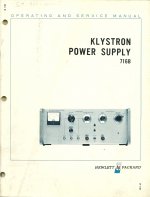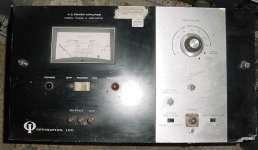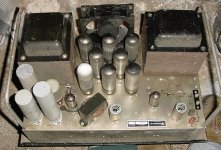There are only a handful of tubes which were designed primarily for audio.
KT66 ? (apart from being a redesigned 6L6)
wasn't KT88 designed for the UL tapped trafo ?
meaning, the industry put their money on high output and supported the UL trafo design, instead the better but lower power Quad II design with cathode feedback trafo
From RC15, presuming that "Output Stage of a radio reciever" qualifies as audio output:
6A3, 6A4, 6AQ5, 6B4G, 6F6, 6G6, 6K6, 6L6, 6V6, (6W6 is a deflection amp, not a replacement for a 6V6 in audio applications)
Finding low dignal level amplifier tubes designed for audio is a bit more difficult as they often serve multi-duty. However the Resistive Coupled Amplifier charts could be presumed to indicate tubes designed for audio use for amplifiing small signal levels.
6A3, 6A4, 6AQ5, 6B4G, 6F6, 6G6, 6K6, 6L6, 6V6, (6W6 is a deflection amp, not a replacement for a 6V6 in audio applications)
Finding low dignal level amplifier tubes designed for audio is a bit more difficult as they often serve multi-duty. However the Resistive Coupled Amplifier charts could be presumed to indicate tubes designed for audio use for amplifiing small signal levels.
Hey all, I work in a very old oil refinery and was wandering through an old warehouse at work where they had old electronics equipment from long long ago stacked all over the place...
Lucky you: gack as much as you can.
Anyway, I found a box full of vacuum tubes that seemed very odd - I know that these old Controls and Monitoring equipment years ago had tubes just like TVs and radios back then, but some of the the tubes I found were audio types - like 2A3, 6L6, 6V6, 12AX7, 12AU7, 6SN7, 6SL7, 6J7, 6SJ7, etc... does this seem odd? Were these tubes used ubiquitously back in 40 / 50 / 60's?
Maybe the guy back then ordering all the tubes was ordering a few for himself for a home hobby?
There are really very few tubes that could be said to be "audio types". A few would include types like the 12AX7 or 6SL7 -- both designed specifically to operate at very low, even sub-milliamp, plate currents so that they could use very large plate load resistors without having to have excessive DC rail voltages.
Or something like the 50C5: designed specifically for operation in Class A. Regardless, such types would work as RF amps up to the VHF bands. The only reason you don't see 12AX7s or 6SL7s used for this are that triodes need to be neutralized if they are to work as RF amps. 50C5s have been used as RF amps (did that myself: used PP 50C5s to make a power amp for a Rat Shack ("Space Commander" CB set). 6V6-oids have been used as drivers/frequency multipliers in RF rigs. After all, the only difference between the "audio" 6L6 and the "RF" 807 is the packaging.
The 6SN7 is more a general purpose type that works well as an audio amp. These have seen applications as oscillator/buffers, in logic circuits, as oscillator/power amps in TV sets (the 6SN7GTB is a special type hardened for just this purpose: Pd increased from 3.5W to 5.0W, grid radiator wings for Vgk > 0 operation, controlled heater characteristic for series string operation).
Lots of VTs were intended for "general purpose" use, unless there was some specific design criteria, such as unusually low noise figures, or use at UHF and above (Magnetrons, Klystrons, TWTs, lighthouse and acorn triodes, UHF grounded grid triodes. Or a pent like the 6AK5: designed mainly for distributed, wideband amps good to 400MHz. (You can find a half dozen of these in many an old o'scope.) Some of these work just swell as audio tubes (6BQ7s make good LTP phase splitters and audio cascodes despite there being no mention of audio anywhere in the spec sheet).
Most "industrial" types are hardened to stand up to harsher environments than the typical listening room, as concerns temp extremes, vibration, or simply lack of repair access (a submarine cable repeater a mile underwater isn't something you want to see any time soon after laying it across the Atlantic). The "computer" tubes had special cathodes that could stand up to long intervals of no plate current mixed with intervals of saturation plate current. That's how logic gates work: either full on or completely off, and it played hell with conventional tubes like the 6SN7, of which early hollow state computers were filled, and which didn't last long under those conditions.
There are really very few tubes that could be said to be "audio types". A few would include types like the 12AX7 or 6SL7
Found a bunch of 6SL7, and 6SN7, as well as 7F7 (Loctal 6SL7), 7N7 (Loctal 6SN7)...the 7N7 / 7F7 are all GE. Also Red Base RCA 5692/5691, also in the 6SN7/6SL7 family...
927 (bulbs?), 6AK5, lots of OW type regulator tubes, 6AR5, 6GE5, 80, 6SJ7, 6J7, 6AU6, 12BH7, oh the list goes on....
Ignore the labels on Loctal tubes. They were all made by Sylvania, at a time when their production was 1st rate.
Somebody mentioned the KTnn group. The only difference between a KT88 and a TT21 is where the plate connection is brought out. The TT21 employs a top cap, which permits higher anode voltages to be used (no arcing). TT = transmitting tetrode, as in short wave.
Somebody mentioned the KTnn group. The only difference between a KT88 and a TT21 is where the plate connection is brought out. The TT21 employs a top cap, which permits higher anode voltages to be used (no arcing). TT = transmitting tetrode, as in short wave.
When I worked for Dunlop Textiles in the 1980s their pilot production plant was a "Computreater", a number of fiersomely hot horizontal ovens and motorised tension wheels controlled from an enormous panel stuffed full of triodes and nixie tubes. I despised that machine. Not sure what the tubes were, I seem to recall they were 9-pin devices about half the height of a 12A*7
Pic is the modern version of the horrendous hellish contraption. I sincerely hope the original is rusting on a river bed somewhere.
An externally hosted image should be here but it was not working when we last tested it.
Pic is the modern version of the horrendous hellish contraption. I sincerely hope the original is rusting on a river bed somewhere.
The're just tubes so one can perform all kinds of tasks with them that require some kind of amplification (analog and digital) or just plain rectification / current steering. The only thing I could think of about "audio tubes" in other tasks but audio-related is that they might not excel in tasks requiring operation at cycle rates way above those audio ranges. ...or something. Today it's naturally easier and often more reliable to perform aforementioned tasks with solid-state technology (e.g. MOSFET motor drivers, commonplace LM3886 chip amps used in driving lathes, cutters, etc.) but back in the days those weren't an option and you used what was the commonplace technology those days: tubes.
...or magamps. ;-) Whatever rocked your boat.
...or magamps. ;-) Whatever rocked your boat.
After looking through a couple of Tube manuals, it looks to me like;
(1) Many Output Tubes were designed with audio specifically in mind. There are many tubes in which the product specifications distinctly call out Radio Output Stage, Audio Output Stage, or some such.
(2) Early on many tubes were specified for audio amplification. However as time went on the number decreased. There are far fewer small signal tubes which specifically call out audio applications other than saying see the "Resistor Coupled Amplifier section".
(3) There is a shift that coincides with the introduction of small 7 and 9 pin based tubes. Fewer tubes (in relative terms) mention audio applications. This may be simply due to the fact that TV was taking over as king of consumer electronics and required many tubes which were specialized for certain functions that made them less applicable as audio amplifier tubes.
In absolute terms there are many "audio" tubes. In relative terms, they are a small percentage of the overall tube types made.
(1) Many Output Tubes were designed with audio specifically in mind. There are many tubes in which the product specifications distinctly call out Radio Output Stage, Audio Output Stage, or some such.
(2) Early on many tubes were specified for audio amplification. However as time went on the number decreased. There are far fewer small signal tubes which specifically call out audio applications other than saying see the "Resistor Coupled Amplifier section".
(3) There is a shift that coincides with the introduction of small 7 and 9 pin based tubes. Fewer tubes (in relative terms) mention audio applications. This may be simply due to the fact that TV was taking over as king of consumer electronics and required many tubes which were specialized for certain functions that made them less applicable as audio amplifier tubes.
In absolute terms there are many "audio" tubes. In relative terms, they are a small percentage of the overall tube types made.
Tektronix used several TV tubes, and "audio tubes" in their scopes. The 504 scope used a 6DQ6 TV sweep tube as the switch element in a primitive SMPS. Several 5 series plugins used 6BQ7's for the vertical amplifiers. Some 5 series mainframes used the 6BQ7 for the distributed amplifier while others used the 6DJ8/ECC88.
The old HP audio oscillators used an Amperex Bugle Boy 5AR4 for the rectifier. The oscillator used a 6AU6 and the output tubes were 6K6's. The later versions used a SS rectifier with 6AU6's and 6CW5's.
The old HP audio oscillators used an Amperex Bugle Boy 5AR4 for the rectifier. The oscillator used a 6AU6 and the output tubes were 6K6's. The later versions used a SS rectifier with 6AU6's and 6CW5's.
I read a post a few weeks back about a Siemens Echo Encephalograph (I think that means "ultrasound" now a days...) as having a E130L (power beam tube), AG5121 (gas filled thyraton, works like a SCR), E80CF (triode-pentode), E83F (pentode), E188CC (double triode), and two EL34 tubes.
Imagine that... your ultrasound machine having two EL34 in push-pull configuration. Take that thing and make it into SE with a switch to chose between triode or ultralinear (and re-bias for KT88 or KT77).
Imagine that... your ultrasound machine having two EL34 in push-pull configuration. Take that thing and make it into SE with a switch to chose between triode or ultralinear (and re-bias for KT88 or KT77).
Not to mention early computers:
it began with ENIAC (not commercial yet) which used - according to wikipedia.org - common octal-base radio tubes of the day; the decimal accumulators were made of 6SN7 flip-flops, while 6L7's, 6SJ7's, 6SA7's and 6AC7's were used in logic functions. Numerous 6L6's and 6V6's served as line drivers to drive pulses through cables between rack assemblies.
IBM early 700 series used - among others - hundreds of
6211, 5965, 5687 double triodes
and 12AY7 as Tape & Drum Amp
European computing equipment had
E180CC, E182CC, E90CC, E91CC
E88CC according to radiomuseum.org: originally designed for use in computer and cascode circuits ...
it began with ENIAC (not commercial yet) which used - according to wikipedia.org - common octal-base radio tubes of the day; the decimal accumulators were made of 6SN7 flip-flops, while 6L7's, 6SJ7's, 6SA7's and 6AC7's were used in logic functions. Numerous 6L6's and 6V6's served as line drivers to drive pulses through cables between rack assemblies.
IBM early 700 series used - among others - hundreds of
6211, 5965, 5687 double triodes
and 12AY7 as Tape & Drum Amp
European computing equipment had
E180CC, E182CC, E90CC, E91CC
E88CC according to radiomuseum.org: originally designed for use in computer and cascode circuits ...
as having a E130L (power beam tube),
I found a box full of used E130L's in a surplus shop in rural Georgia (US). The owner said that he had pulled them from medical equipment. They are mostly Mullard and Tungsram. I got the whole box for $20.
I have seen electrosurgery units that are powered by a 211 tube. An electrosurgery unit is a radio transmitter that goes from zero to 500 watts in one of the HF ISM frequency bands, usually 6.780 MHz or 13.560 MHz.
I have been on the business end of a modern version of these things. The machine generates a RF plasma that burns off skin cancers and everything else that they touch. The machine in my doctors office is a "Hyfrecator" (high frequency eradicator). It is solid state and makes a most evil buzz.....along with the smell of crispy flesh.....mine!
Not to mention early computers:
it began with ENIAC (not commercial yet) which used - according to wikipedia.org - common octal-base radio tubes of the day;
<cut>
Earlier than ENIAC (built over 10 months in 1943 under the inspired Tommy Flowers, of the UK Post Office Telecommunications, Dollis Hill) and in full service by April 1944: The COLOSSUS was a 1500-valve digital computer, used to attack encrypted military signals traffic.
Although the destruction of all design information was ordered after its work was finished, Tony Sale has rebuilt one -
Colossus Rebuild - Tony Sale
See also:
Gannon, P., "Colossus" Altlantic books, 2006
an extraordinary story, this book is worth looking out for.
Last edited:
Yup, they sure did. And some of the older Tek scopes also had 5AR4s in them. HP used 6L6s in at least one of their larger audio oscillators as well. The 205AG I think.Tektronix used several TV tubes, and "audio tubes" in their scopes. The old HP audio oscillators used an Amperex Bugle Boy 5AR4 for the rectifier.
Now, I'll diulge a few of my secret instrument sources for output tubes. The best Hewlett Packard unit is the 716B klystron power supply. Inside you will find six EL34s used as series pass elements. The type 738BR calibrator has two 6550s and a nice wideband output transformer of at least fifty watts. And speaking of calibrators, Optimation made a wideband AC calibration system that used a precision oscillator driving a large amplifier to supply high voltage. It used eight EL34s in push-pull parallel. Some were found with 8417s. These amplifiers actually sounded very good as is for music. The company was taken over by Julie Research Labs, but is now long gone. I have several of these from long ago. Pictured is one of the scrap units I kept for parts.
And I'm sure many of you know about the old Lambda and Kepco high voltage lab supplies that used 6550s and 6L6GCs as pass tubes. And there were other lesser known brands that were good for these same tubes.
Attachments
I believed it would be possible to rebuild Colossus...Nobody believed me.
Thanks also to:
The many hundreds of individuals who have searched their garages and lofts and sent valves for Colossus.
A gentleman came to see me at the Dayton Hamfest with a list of "valves" he was looking for. He was from England and had a story about a WWII computer in Bletchley Park that he was rebuilding. He had pictures and was very convincing. I wasn't sure whether to believe him or not especially considerint the types of tubes he was looking for.....5U4's and 807's aren't exactly computer tubes, but then computer tubes weren't invented yet when Colossus was built. I gave him a box full of tubes anyway. About a year later I read this story in Elektor.
The guy also told me that there was a German Enigma machine up and running somewhere and they were using it to generate test ciphers!
- Status
- This old topic is closed. If you want to reopen this topic, contact a moderator using the "Report Post" button.
- Home
- Amplifiers
- Tubes / Valves
- Audio Tubes used in Industrial equipment?


